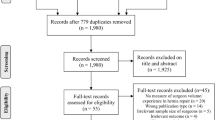Abstract
Background
Increased focus and research on surgical technique and anaesthesia in groin hernia repair have improved outcomes from centres of interest in hernia surgery, but little information is available from nationwide data to document the incorporation of scientific evidence into general clinical practice.
Aim
To review outcomes after groin hernia repair in Denmark from the Danish Hernia Database 1998–2005 in 87,840 patients.
Results
The nationwide Danish hernia collaboration with two annual meetings discussing own results and those of others has led to >50% reduction in reoperation rates, increased use of the Lichtenstein hernia technique, higher rate of outpatient surgery, near elimination of regional anaesthesia, and documentation and focus on incidence and mechanisms of chronic pain.
Conclusion
Establishment of nationwide groin hernia databases leads to general improvement in outcomes and, due to the large number of patients, allows analyses of specific sub-groups or complications which otherwise could not be obtained from single centres. Nationwide collaboration is important for multi-centre research and further improvement of outcomes, especially in chronic pain.






Similar content being viewed by others
References
Bay-Nielsen M, Kehlet H, Strand L et al (2001) Quality assessment of 26,304 herniorrhaphies in Denmark: a prospective nationwide study. Lancet 358:1124–1128
O’Riordan DC, Kingsnorth AN (1998) Audit of patient outcomes after herniorrhaphy. Surg Clin North Am 78:1129–1139
Nilsson E, Haapaniemi S (2002) Assessing the quality. In: Fitzgibbons RJ, Greenburg AG (eds) Nyhus and Condon’s hernia. Lippincott, Williams and Wilkins, Philadelphia, pp 567–573
Klinge U, Krones CJ (2005) Can we be sure that the meshes do improve the recurrence rates? Hernia 9:1–2
Aufenacker TJ, de Lange DH, Burg MD et al (2005) Hernia surgery changes in the Amsterdam region 1994–2001: decrease in operations for recurrent hernia. Hernia 9:46–50
Atkinson HD, Nicol SG, Purkayastha S et al (2004) Surgical management of inguinal hernia: retrospective cohort study in southeastern Scotland, 1985–2001. BMJ 329:1315–1316
Bay-Nielsen M, Kehlet H (1999) Establishment of a national Danish hernia database—preliminary report. Hernia 3:81–83
Wara P, Bay-Nielsen M, Juul P et al (2005) Prospective nationwide analysis of laparoscopic versus Lichtenstein repair of inguinal hernia. Br J Surg 92:1277–1281
Bisgaard T, Bay-Nielsen M, Christensen IJ et al (2007) Risk of recurrence 5 years or more after primary Lichtenstein mesh versus sutured inguinal hernia repair. A prospective nationwide study. Br J Surg 94:1038–1040
Bay-Nielsen M, Nordin P, Nilsson E et al (2001) Operative findings in recurrent hernia after a Lichtenstein procedure. Am J Surg 182:134–136
Bay-Nielsen M, Kehlet H (2006) Inguinal herniorrhaphy in women. Hernia 10:30–33
Koch A, Edwards A, Haapaniemi S et al (2005) Prospective evaluation of 6,895 groin hernia repairs in women. Br J Surg 92:1553–1558
Mikkelsen T, Bay-Nielsen M, Kehlet H (2002) Risk of femoral hernia after inguinal herniorrhaphy. Br J Surg 89:486–488
Kehlet H, Aasvang E (2005) Groin hernia repair: anesthesia. World J Surg 29:1058–1061
Callesen T, Bech K, Kehlet H (2001) One-thousand consecutive inguinal hernia repairs under unmonitored local anesthesia. Anesth Analg 93:1373–1376
Kingsnorth AN, Porter C, Bennett DH (2000) The benefits of a hernia service in a public hospital. Hernia 4:1–5
Kark AE, Kurzer MN, Belsham PA (1998) Three thousand one hundred seventy-five primary inguinal hernia repairs: advantages of ambulatory open mesh repair using local anesthesia. J Am Coll Surg 186:447–455
Nordin P, Zetterström H, Carlsson P et al (2007) Cost-effectiveness analysis of local, regional and general anaesthesia for inguinal hernia repair using data from a randomized clinical trial. Br J Surg 94:500–505
Kehlet H, Bay-Nielsen M (2005) Anaesthetic practice for groin hernia repair. A nation-wide study in Denmark 1998–2003. Acta Anaesthesiol Scand 49:143–146
Bay-Nielsen M, Kehlet H (2007) Anaesthesia and postoperative morbidity after elective groin hernia repair—a nationwide study. Acta Anaesthesiol Scand (in press)
Bay-Nielsen M, Thomsen H, Andersen FH et al (2004) Convalescence after inguinal herniorrhaphy. Br J Surg 91:362–367
Bay-Nielsen M, Perkins FM, Kehlet H (2001) Pain and functional impairment 1 year after inguinal herniorrhaphy: a nationwide questionnaire study. Ann Surg 233:1–7
Aasvang E, Kehlet H (2005) Chronic postoperative pain: the case of inguinal herniorrhaphy. Br J Anaesth 95:69–76
Bay-Nielsen M, Nilsson E, Nordin P et al (2004) Chronic pain after open mesh and sutured repair of indirect inguinal hernia in young males. Br J Surg 91:1372–1376
EU Hernia Trialist Collaboration (2000) Laparoscopic compared with open methods of groin hernia repair: systematic review of randomized controlled trials. Br J Surg 87:860–867
Aasvang EK, Bay-Nielsen M, Kehlet H (2006) Pain and functional impairment 6 years after inguinal herniorrhaphy. Hernia 10:316–321
Aasvang EK, Mohl B, Bay-Nielsen M et al (2006) Pain related sexual dysfunction after inguinal herniorrhaphy. Pain 122:258–263
Aasvang EK, Mohl B, Kehlet H (2007) Ejaculatory pain and sexual dysfunction following groin hernia repair—a specific pain syndrome? Anesthesiology 107:298–304
Aasvang EK, Brandsborg B, Christensen B et al (2007) Neurophysiological characterization of postherniorrhaphy pain. Pain (in press)
Aasvang E, Kehlet H (2005) Surgical management of chronic pain after inguinal hernia repair. Br J Surg 92:795–801
Sandblom G, Haapaniemi S, Nilsson E (1999) Femoral hernias: a register analysis of 588 repairs. Hernia 3:131–134
Nilsson H, Stylianidis G, Haappamäki M et al (2007) Mortality after groin hernia surgery. Ann Surg 245:656–660
Jensen P, Bay-Nielsen M, Kehlet H (2004) Planned inguinal herniorrhaphy but no hernia sac? Hernia 8:193–195
Author information
Authors and Affiliations
Consortia
Corresponding author
Rights and permissions
About this article
Cite this article
Kehlet, H., Bay-Nielsen, M. & for the Danish Hernia Database Collaboration. Nationwide quality improvement of groin hernia repair from the Danish Hernia Database of 87,840 patients from 1998 to 2005. Hernia 12, 1–7 (2008). https://doi.org/10.1007/s10029-007-0285-5
Received:
Accepted:
Published:
Issue Date:
DOI: https://doi.org/10.1007/s10029-007-0285-5




